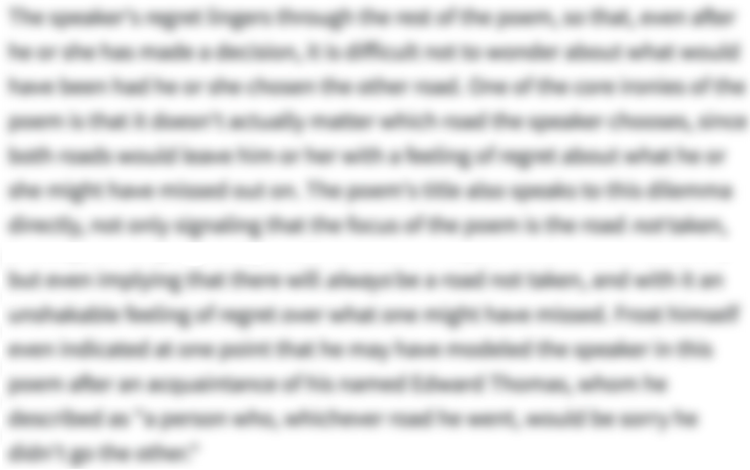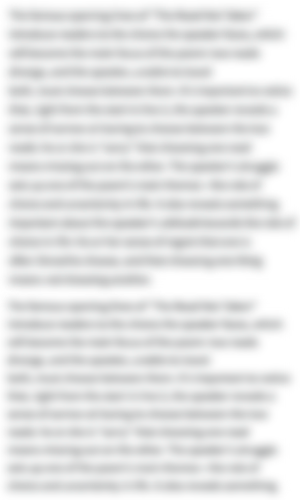The Full Text of “Hope is the thing with feathers”
1“Hope” is the thing with feathers -
2That perches in the soul -
3And sings the tune without the words -
4And never stops - at all -
5And sweetest - in the Gale - is heard -
6And sore must be the storm -
7That could abash the little Bird
8That kept so many warm -
9I’ve heard it in the chillest land -
10And on the strangest Sea -
11Yet - never - in Extremity,
12It asked a crumb - of me.
-
“Hope is the thing with feathers” Introduction
-
"Hope is the thing with feathers" (written around 1861) is a popular poem by the American poet Emily Dickinson. In the poem, "Hope" is metaphorically transformed into a strong-willed bird that lives within the human soul—and sings its song no matter what. Essentially, the poem seeks to remind readers of the power of hope and how little it requires of people. The speaker makes it clear that hope has been helpful in times of difficulty and has never asked for anything in return. "Hope is the Thing with Feathers" is one of a number of poems by Dickinson that breathes new life into an abstract concept by using surprising imagery and figurative language.
-
-
“Hope is the thing with feathers” Summary
-
The speaker defines "Hope" as a feathered creature that dwells inside the human spirit. This feathery thing sings a wordless tune, not stopping under any circumstances.
Its tune sounds best when heard in fierce winds. Only an incredibly severe storm could stop this bird from singing. The "Hope" bird has made many people feel warm.
The speaker has heard the bird's singing in the coldest places, and on the weirdest seas. But in the speaker's experiences, even the most extreme ones, the bird has never asked for anything in return.
-
-
“Hope is the thing with feathers” Themes
-
Hope
“Hope is the thing with feathers” is a kind of hymn of praise, written to honor the human capacity for hope. Using extended metaphor, the poem portrays hope as a bird that lives within the human soul; this bird sings come rain or shine, gale or storm, good times or bad. The poem argues that hope is miraculous and almost impossible to defeat. Furthermore, hope never asks for anything in return—it costs nothing for people to maintain hope. By extension, then, “Hope is the thing with feathers” implores its readers to make good use of hope—and to see it as an essential, deeply valuable part of themselves.
The poem begins by establishing its key metaphor—that hope is a bird. It then tells the reader more about this bird, adding detail, before showing it in different situations. The poem concludes by stating that, despite all it does, hope never asks for anything from the speaker. Overall, then, the poem turns hope into a vivid imagined character in order to show how important it is, both to individuals and to humanity as a whole.
The poem initially defines hope as “the thing with feathers.” Though it’s obvious that this is a bird (as confirmed in line 7), the unusualness of this first description shows that the poem wants the reader to look afresh at hope—to see hope with clear eyes and not take it for granted. Starting with “hope is a bird” would have the same literal meaning but would feel much less surprising, and the surprise element helps establish the poem’s purpose of redefining hope.
This "Hope" bird “perches” in the soul, showing that the soul itself is hope’s home. Hope is thus directly linked with the human spirit, where it sings without ever stopping. This perseverance, then, is a representation of humanity’s infinite capacity for hope. Even in the depths of despair, the poem seems to say, people can still have hope—and this hope will sustain them. Indeed, the bird sings “sweetest” in the storm. In other words, hope shows its importance in times of adversity and seems to guide people through that adversity. This point could apply to humanity’s challenges in a general sense, or it could relate to more personal experiences like individual grief and loss. In either case, hope gives people the strength to carry on, and it’s at its most useful when circumstances are at their worst.
Of course, there might be times when people do seem to lose their strength—but, the poem argues, hope still plays an important role in these situations. The poem demonstrates this by gesturing towards the sheer number of people (“so many”) who have been sustained by hope, saying that it would have to be a truly “sore” “storm” that could diminish the strength of “the little Bird.” Hope, it seems, can keep people “warm” even in the worst situations.
And though hope is so essential to human life, the beauty of it—according to the poem—is that it requires practically nothing of people. Hope costs nothing, not a “crumb”—yet it can literally and figuratively keep people alive. With hope, people can make it through the hardest of times—they just have to listen to “the little Bird” singing its tune. Overall, then, “Hope is the thing with feathers” implores its readers to value their capacity for hope—and to recognize that it’s never really gone. Without becoming overly specific, the poem argues that hope can be especially helpful in the most extreme situations and that people should therefore rely on it as a precious resource.
- See where this theme is active in the poem.
-
-
Line-by-Line Explanation & Analysis of “Hope is the thing with feathers”
-
Lines 1-2
“Hope” is the thing with feathers -
That perches in the soul -This poem is one of a number of works by Dickinson which work as a kind of extended definition, taking a particular word and casting it in a new, surprising light. Often, Dickinson does this through taking abstract concepts and applying concrete ideas or images to them—which happens in this poem by making "hope" into a bird. Of all Dickinson's "definition" poems, this is probably the most well-known. The opening line makes the poem's intentions clear—it will aim to explain how hope is like a bird, and why that connection is important in the first place.
This said, it's important to note that the poem doesn't start by stating its metaphor directly; it doesn't say that "hope is a bird." Aside from being much less interesting, a line like that would require less imaginative engagement on the reader's part. Instead, hope is "the thing with feathers." The reader might well think of a bird immediately, but the phrase allows for a certain conceptual distance that justifies the rest of the poem—the following lines will explain what this "thing" is, and in what way it represents hope. This slightly mysterious beginning implies that people might not always recognize their own capacity for hope. The delicate consonance of /th/ in "thing," "feathers," and "that" also helps the poem get off to a gentle start, as though it is feeling its way into this new definition of hope. The meter of the line adds to this gentleness too. It's the only one in the poem to end with an unstressed syllable (apart from possibly line 11):
“Hope” is | the thing | with fea- | -thers -
The trochaic first foot also places strong emphasis on the word "hope," which is, of course, the whole point of the poem: to argue for the importance of hope.
The second word of line 2, for most readers, probably confirms that this "Hope" thing is indeed a bird. "Perch" is a verb used almost exclusively for birds, and as a noun, the word has a connotation of signifying the bird's home or the place where it is at rest (think of how a bird in a cage rests on its perch). This "Hope" bird, the reader now knows, rests within "the soul," which is the poem's way of saying that hope is a fundamental part of being a human. The image also suggests that hope is always present—it's something that people can always return to, just as a bird returns to its perch.
-
Lines 3-4
And sings the tune without the words -
And never stops - at all -

Unlock all 329 words of this analysis of Lines 3-4 of “Hope is the thing with feathers,” and get the Line-by-Line Analysis for every poem we cover.
Plus so much more...
Get LitCharts A+ -
Lines 5-8
And sweetest - in the Gale - is heard -
And sore must be the storm -
That could abash the little Bird
That kept so many warm - -
Lines 9-10
I’ve heard it in the chillest land -
And on the strangest Sea - -
Lines 11-12
Yet - never - in Extremity,
It asked a crumb - of me.
-
-
“Hope is the thing with feathers” Symbols
-
Birdsong
Through extended metaphor, hope is transformed into a bird that rests within the human soul. As part of this metaphor, the poem draws a symbolic link between birdsong and the indomitable (undefeatable) power of hope. The song is the musical expression of hope, a small signal of joy that can be heard even in the worst of times. It is also a wordless "tune," which indicates that is something deeply felt and innate in humans; that is, hope is almost beyond language itself.
In fact, the song sounds "sweetest" when it is heard "in the Gale." That is, hope is most effective in times of trouble. Its song links difficult times in the present with better times to come.
- See where this symbol appears in the poem.
-
-
“Hope is the thing with feathers” Poetic Devices & Figurative Language
-
Anaphora
The poem uses anaphora in lines 7 and 8, though the polysyndeton (the "ands") of lines 3 through 6 is a type of anaphora too.
The anaphora works (along with the polysyndeton) to create an atmosphere of intense perseverance throughout the entire poem. One of the poem's main points is that hope is almost impossible to defeat, which is why it is so important to humanity—indeed, hope is most useful when times are hardest. The repetitive line beginnings, then, evoke strength—the ability to push on one from moment to the next without losing any momentum. Indeed, lines 5 through 8 have to literally weather the storm that they describe, with the "ands" and "thats" working like anchors steadying a ship.
In fact, "ands" and "thats" form the beginnings of eight out of the poem's twelve lines—two thirds of the entire poem. Apart from the first line, which works as an introduction, and the lines in the final stanza that deal with the speaker's personal experience, every line is anaphoric. In other words, anaphora is everywhere—just like hope.
There is another way of looking at this anaphora, too. Part of the "Hope" bird's power is in its song, which is a symbol of joy, beauty, and strength. Since one way of defining music is by thinking of it as the patterned organization and variation of sound, then the anaphora can be read as part of the bird's melody too. That is, it helps the lines combine repetition and variation in much the same way that real birdsong might.
- See where this poetic device appears in the poem.
-
Consonance


Unlock all 292 words of this analysis of Consonance in “Hope is the thing with feathers,” and get the poetic device analyses for every poem we cover.
Plus so much more...
Get LitCharts A+ -
Extended Metaphor
-
Pathetic Fallacy
-
Polysyndeton
-
Alliteration
-
Assonance
-
-
“Hope is the thing with feathers” Vocabulary
Select any word below to get its definition in the context of the poem. The words are listed in the order in which they appear in the poem.
- Perches
- Gale
- Sore
- Abash
- Chillest
- Extremity
- Crumb
Perches-
To perch is to alight or come to rest on something, as a bird might do on a branch. A perch can also be a noun, denoting the object being landed on.
- See where this vocabulary word appears in the poem.
-
Form, Meter, & Rhyme Scheme of “Hope is the thing with feathers”
-
Form
"Hope is the thing with feathers" is one of a number by Dickinson which can perhaps be called her "definition poems." These are poems that start with an abstract concept (here, "hope"), followed by an "is," which is in turn followed by the main body of the poem that explains and justifies the comparison. This isn't done to show off the poet's skill of comparison and imagery, but to cast fresh light on the concept itself. Here, of course, hope is redefined as a bird, specifically one that dwells within the human soul. There are a number of poems that work in a similar way—there are even two others that also define "hope:" "Hope is a strange invention" and "Hope is a subtle glutton."
Put broadly, the poem is one long extended metaphor, written in three quatrain stanzas. The first stanza introduces the metaphor and the bird's song; the second demonstrates the bird's resilience; and the third brings the poem into the more personal experience of the speaker.
-
Meter
"Hope is the thing with feathers" has a fairly regular meter that alternates between lines. Each stanza begins with a line of iambic tetrameter (four poetic feet, each with a da DUM syllable pattern) followed by a line of iambic trimeter (three feet of the same unstressed-stressed pattern). This pattern then repeats in the second half of each stanza too, making the entire poem conform to this alternating pattern. In fact, all lines follow this scheme except for the first. To take the second quatrain as an example, the pattern is as follows:
And sweet- | est - in | the Gale - | is heard - |
And sore | must be | the storm - |
That could | a-bash | the litt-| le Bird |
That kept | so man-| y warm - |The regularity of the meter makes the poem sound musical, like a song. This makes sense, as much of it is about the "Hope" bird's singing. Indeed, this metrical scheme is often called "hymn meter" precisely because it lends itself well to being sung. A number of church hymns follow this pattern—as do many Dickinson poems (e.g. "Because I Could not Stop for Death"). This meter is also known as "common meter."
The first line notably stands out in this otherwise metrically stable poem, and has two variations in the meter. The first foot opens with a trochee (stressed-unstressed), which places strong emphasis on the word "hope"—which is, after all, the poem's main subject. The other difference is that the final foot is catalectic, which means that it is missing a syllable. In this case, there would be a final stressed syllable after "feathers"—but the fact that there isn't makes the line sound much more gentle and, indeed, feather-like:
"Hope" is | the thing | with fea-| thers -
-
Rhyme Scheme
"Hope is the thing with feathers" has a fairly regular rhyme scheme. The first two stanzas are rhymed:
ABAB
The final stanza is a little different:
ABBB
The rhymes combine with other poetic elements to create a musical-sounding poem, which is in keeping with the discussion of birdsong.
The first stanza also uses slant rhymes, which is characteristic of Dickinson's poetry: feathers/words, soul/all. Perhaps this is because the poem is still feeling its way into its redefinition of "Hope"; or perhaps it evokes the preciousness of the small, feathery bird.
In the second stanza, the rhymes are more solid: heard/bird and storm/warm. Seeing as this stanza discusses the bird singing through storms, it makes sense that the "volume" of the rhymes here is louder. The bird has to sing louder to be heard in such strong winds—just as hope is at its most useful in times of distress.
The triple rhyme in the poem's last three lines—Sea/Extremity/me—is suggestive of the speaker's personal experiences. That is, the increase in rhymes hints at the "extremity" of the times that the speaker is describing—those moments when life is at its toughest.
-
-
“Hope is the thing with feathers” Speaker
-
The speaker in "Hope is the thing with feathers" is unspecified. Critics do draw parallels between the speaker of Dickinson's poems and the poet herself, but it would do a disservice to the power of her poetry by limiting its interpretation to autobiography. As with a number of Dickinson's poems, the speaker here seeks to offer up a new definition of an abstract concept: in this case, hope. This is a kind of imaginative challenge to both the speaker and the reader—the former must justify the metaphor (hope as a bird) and the latter must go on that journey with them in order to see the abstract concept afresh.
In the first two stanzas, the speaker talks in universal terms about the "Hope" bird. It's in the final stanza that the speaker's authority to speak on the subject becomes clear. Here, the speaker relates how the metaphorical bird of hope helped the speaker through tough times—yet never asked a "crumb" in return. The poem generally has a confident and happy tone which is felt to be partly based on the way in which hope has helped the speaker through these difficult times. In other words, this person is talking from experience—and wants to gently remind the reader of the power of hope.
-
-
“Hope is the thing with feathers” Setting
-
"Hope is the thing with feathers" is one of a number of Dickinson poems that takes an abstract concept and refreshes it with concrete language and images. Here, there is one extended metaphor throughout: hope is a bird. The setting of the poem plays out as metaphor grows, and subtly changes from stanza to stanza. Thought of in the broadest terms, the whole poem takes place in the speaker's mind—or, perhaps, in the space between the speaker and the reader. That is, the speaker asks the reader to follow along on an imaginative journey that justifies the idea that hope can be thought of as a bird.
More specifically, the first stanza introduces the human soul as a kind of location in which the "Hope" bird lives. The second stanza conjures up storms and gales, through which the song of hope can still be heard (and, in fact, sounds sweeter). The final stanza brings the poem more into the realm of personal experience, with the speaker showing how hope has helped them. The setting at the end, then, is the speaker's world.
-
-
Literary and Historical Context of “Hope is the thing with feathers”
Literary Context
Emily Dickinson (1830-1886), one of the world's most influential and beloved poets, might never have been known at all. During her lifetime, she published only a handful of the nearly 1,800 poems she composed, preferring to keep much of her writing private. If Dickinson's sister Lavinia hadn't discovered a trunkful of poetry hidden in Dickinson's bedroom after her death, that poetry could have been lost.
Perhaps it's partly because of her separation from the literary mainstream that Dickinson's poetry is so idiosyncratic and distinctive. While her interest in the power of nature and the workings of the soul mark her as a voice of the American Romantic movement, her work didn't sound like anyone else's. Combining the common meter rhythms of hymns with strange, spiky, dash-riddled diction, Dickinson's poems often plumbed eerie psychological depths over the course of only a few lines.
Dickinson was inspired both by contemporary American Transcendentalists—like Emerson, whose essays on self-reliance she deeply admired—and by the work of earlier English writers like Charlotte Brontë and William Wordsworth. All these writers shared an interest in the lives of ordinary people and struggled for inner freedom in a 19th-century world that often demanded conformity.
"Hope is the thing with Feathers" belongs to the category of Dickinson's work that might be called "definition poems." In these, the speaker sets out an abstract noun which is then discussed in concrete terms and images; this refreshes the abstract concept and casts it in a new light. Other famous poems that follow a similar setup are "Grief is a Mouse" and "Fame is a Bee." Indeed, there are two other similar poems on hope specifically: "Hope is a strange invention" and "Hope is a subtle glutton."
Historical Context
Emily Dickinson lived in small-town Amherst, Massachusetts all her life. She grew up in a strict Protestant environment that placed great emphasis on religious rules and social codes; in fact, her family line can be traced back to the 16th-century Puritan settler John Winthrop. Though she ultimately rejected organized religion, her poems remain preoccupied with theological concerns (including the existence of an afterlife and competing ideas about the ways in which people ought to serve God). Dickinson's religious upbringing also shows itself in the hymn-like tones and rhythms of her poetry.
Dickinson wrote most of her poetry during the American Civil war, which ran from 1861 to 1865. She was firmly on the Union side of that bloody conflict; in one of her letters, she writes with delight about the ignominious defeat of Confederate president Jefferson Davis, who was reportedly trying to make his escape disguised in a woman's skirt when he was finally captured. She even contributed three anonymous poems—some of only a handful she published during her lifetime—to a fundraising magazine in support of the Union army.
However, Dickinson rarely addressed the political world around her directly in her poetry, preferring either to write about her immediate surroundings or to take a much wider philosophical perspective. And by all accounts, Dickinson's life was extremely unusual for the time. Most women were expected to marry and have children, but she never did; in fact, towards the end of her life, she barely spoke to anyone but a small circle of close friends and family. She spent most of her time shut up in her room, relatively immune to what was taking place outside in the wider world.
-
More “Hope is the thing with feathers” Resources
-
External Resources
-
Further Educational Resources — Resources for students about Emily Dickinson provided by the Dickinson museum (situated in her old house).
-
The Poem Out Loud — A reading of the poem by Mairin O'Hagan.
-
The Original Poem — An image of the poem in Dickinson's own handwriting.
-
Other Dickinson Poems — A link to numerous other Emily Dickinson poems.
-
More About the History of Hope — A BBC radio documentary in which experts discuss the concept of hope and its history.
-
-
LitCharts on Other Poems by Emily Dickinson
-










